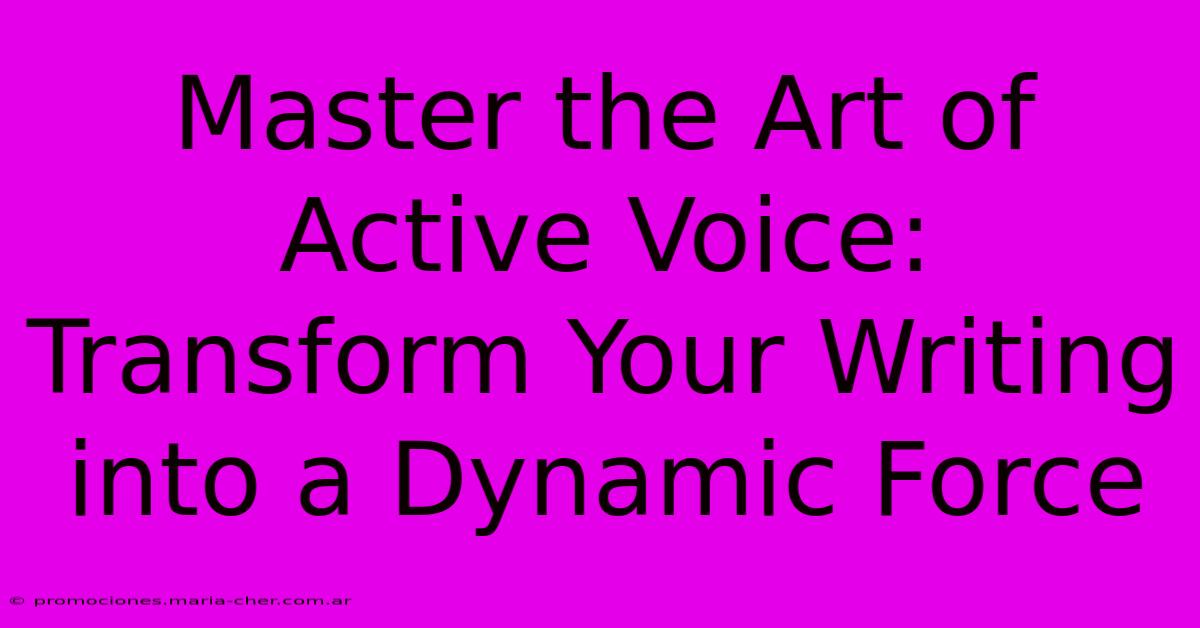Master The Art Of Active Voice: Transform Your Writing Into A Dynamic Force

Table of Contents
Master the Art of Active Voice: Transform Your Writing into a Dynamic Force
Writing is a powerful tool. Whether you're crafting a compelling blog post, a persuasive marketing email, or a captivating novel, your words have the potential to influence, inform, and inspire. But how do you ensure your writing is clear, concise, and impactful? The answer lies, in large part, in mastering the art of the active voice.
What is Active Voice?
In active voice, the subject of the sentence performs the action. The structure is simple: Subject + Verb + Object. For example:
- Active: The dog chased the ball.
In this sentence, "dog" (subject) performs the action "chased" (verb) on "ball" (object).
The Power of Active Voice: Why It Matters
Active voice isn't just a grammatical rule; it's a stylistic choice that significantly impacts your writing's effectiveness. Here's why you should prioritize it:
1. Clarity and Conciseness:
Active voice eliminates unnecessary words and makes your writing easier to understand. It gets straight to the point, minimizing ambiguity and confusion. Compare the active and passive examples below:
- Passive: The ball was chased by the dog.
- Active: The dog chased the ball.
The active version is shorter, clearer, and more direct.
2. Stronger Impact:
Active voice is more forceful and engaging. It creates a sense of immediacy and dynamism, making your writing more impactful and memorable.
3. Improved Readability:
Shorter sentences, a hallmark of active voice, significantly improve readability. Readers digest information more quickly and easily, leading to a more enjoyable reading experience.
4. Enhanced Authority:
Using active voice projects confidence and authority. It makes you sound knowledgeable and in control of your subject matter.
Transforming Passive Voice into Active Voice: Practical Tips
Many writers unknowingly overuse passive voice. Here's how to identify and transform it:
-
Identify the "to be" verbs: Look for forms of "to be" (is, am, are, was, were, be, been, being). These are often indicators of passive voice.
-
Find the hidden subject: Passive sentences often bury the true actor of the action. Uncover it!
-
Rearrange the sentence: Place the subject at the beginning and reconstruct the sentence in the active voice format.
Example:
- Passive: The report was written by John.
- Active: John wrote the report.
Beyond the Basics: Nuanced Applications of Active Voice
While active voice is generally preferred, there are instances where passive voice might be appropriate:
- When the actor is unknown or unimportant: The window was broken.
- To emphasize the action, not the actor: The painting was carefully restored.
- To maintain objectivity: The study concluded that…
However, these exceptions should be used sparingly. The vast majority of your writing should utilize the power of active voice.
Conclusion: Embrace Active Voice for Powerful Writing
Mastering active voice is a crucial skill for any writer. It enhances clarity, strengthens impact, improves readability, and builds your authority. By consistently applying these techniques, you can transform your writing from mundane to magnificent, creating a dynamic and engaging experience for your readers. So, go forth and write with power!

Thank you for visiting our website wich cover about Master The Art Of Active Voice: Transform Your Writing Into A Dynamic Force. We hope the information provided has been useful to you. Feel free to contact us if you have any questions or need further assistance. See you next time and dont miss to bookmark.
Featured Posts
-
Resignate
Feb 09, 2025
-
Artefacts
Feb 09, 2025
-
Unleash The Strength Of Active Voice Convert Passive Phrases Into Dynamic Wonders
Feb 09, 2025
-
Regrets And Restitution Our Plan To Compensate For The Inconvenience We Ve Caused
Feb 09, 2025
-
Beyond The Bubbly The Hidden Differences Between Champagne And Champaign
Feb 09, 2025
